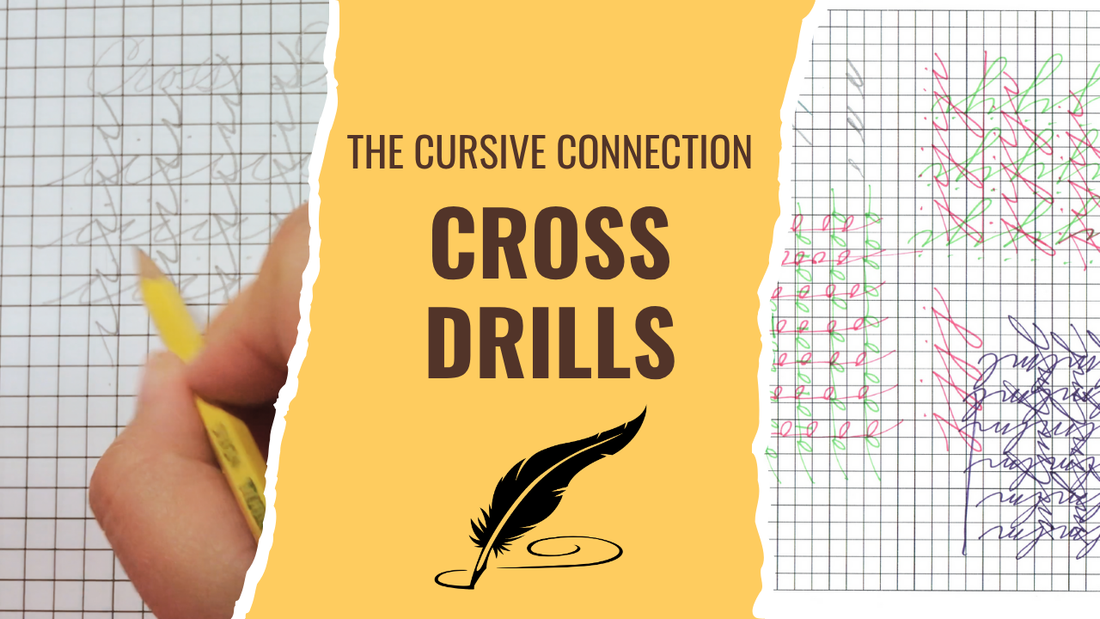If you've ever wondered why your cursive writing looks uneven or struggles with consistent spacing, cross drills might be the practice technique you've been missing. This simple yet powerful exercise, used daily in The Cursive Connection curriculum, transforms irregular handwriting into beautifully consistent penmanship.
What Are Cross Drills?
Cross drills are a systematic practice method where you write letters horizontally across graph paper, then rotate the page and write through the same spaces vertically, creating a crosshatch pattern. Think of it like a jigsaw puzzle for your handwriting—if your letters are consistent in shape and spacing, the crossing patterns will align perfectly.
This technique reveals inconsistencies immediately, making it easier to self-correct and develop the muscle memory needed for beautiful cursive writing.
Why Cross Drills Work
Cross drills help develop three critical elements of quality penmanship:
Consistent Spacing: Using quarter-inch grid paper, you practice keeping one unit of space between each letter. This trains your hand to maintain even spacing naturally.
Letter Shape Consistency: When letters cross at perpendicular angles, inconsistencies in letter formation become obvious. A stretched-out letter looks different from a compressed one when viewed from both directions.
Writing Speed and Flow: Regular cross drill practice builds the muscle memory that allows you to write smoothly and consistently without conscious effort.
How to Practice Cross Drills
Materials Needed:
- Quarter-inch grid paper (included in The Cursive Connection boxed set)
- Pencil or pen
- Optional: Multiple colored pens for visual distinction
Basic Technique:
- Write horizontally first: Practice one letter repeatedly across the page, using the grid to maintain one unit of space between letters and one unit height for the letter itself.
- Maintain consistent spacing: Space, letter, space, letter—the grid lines guide your spacing.
- Skip appropriate space below: If your letter is one unit high, skip one unit down before starting the next row.
- Rotate and cross: Turn your paper 90 degrees and write the same letter through the spaces where horizontal letters connect.
- Evaluate consistency: Look at the crosshatch pattern. Do the shapes align like puzzle pieces? Inconsistencies will be obvious.
Cross Drill Examples
Simple Letters (like lowercase 'i'):
- One unit high, one unit of space between
- Creates tight, consistent patterns
- Perfect for beginners learning basic spacing
Standard Letters (like lowercase 'a'):
- One unit for the letter, one unit for spacing
- Shows how consistent letter formation creates aligned crosses
- Reveals when letters are too compressed or stretched
Tall Letters (like lowercase 'j'):
- Two units high, still one unit spacing
- Skip two units between rows
- Can use different colors for horizontal and vertical passes for better visibility
The Historical Context
Cross drills aren't just a teaching tool—they have historical roots. During the Great Depression, people practiced cross writing to save paper, writing a full letter horizontally, then rotating and continuing vertically in another color. This made every sheet of paper twice as useful while maintaining legibility.
Common Improvements from Cross Drills
Students who practice cross drills regularly notice:
- More even letter spacing across all writing
- Consistent letter heights and proportions
- Improved writing rhythm and flow
- Better ability to self-assess and correct
- Faster development of muscle memory
Tips for Effective Practice
Don't erase mistakes: Keep practicing to build muscle memory. Seeing your inconsistencies helps you correct them.
Use the grid strategically: Let the grid guide your spacing without becoming dependent on it.
Try different letters: Practice various lowercase letters to develop versatility.
Use color for clarity: When crossing, use a different color to distinguish vertical from horizontal strokes.
Practice regularly: Daily cross drills in the beginning stages accelerate learning.
When to Use Cross Drills
Cross drills work best:
- At the beginning of cursive learning to establish fundamentals
- As daily warm-up exercises before writing practice
- When struggling with spacing issues
- To improve specific letter formations
- For building speed without sacrificing consistency
The Cursive Connection Approach
In The Cursive Connection curriculum, cross drills are integrated into early lessons as students learn lowercase letters. This systematic approach ensures students develop proper habits from the start rather than correcting bad habits later.
The curriculum includes:
- Quarter-inch graph paper pads in the boxed set
- Specific cross drill exercises for each letter
- Progressive difficulty as students advance
- Integration with other penmanship techniques
Beyond Basic Practice
Once you've mastered basic cross drills, you can:
- Practice letter combinations and connections
- Work on speed while maintaining consistency
- Challenge yourself with more complex letters
- Use cross drills as diagnostic tools to identify specific areas needing work
See Cross Drills in Action
Watch the full tutorial demonstrating cross drills with multiple letters, showing exactly how to use the grid paper, maintain spacing, and create those perfect crosshatch patterns that indicate consistent handwriting.
Watch the Cross Drills Tutorial on YouTube
Making Handwriting Practice Engaging
Cross drills transform what could be tedious repetition into a visual challenge. Students can see their progress immediately—when the patterns align perfectly, they know they've achieved consistency. This visual feedback makes practice more engaging and motivating.
The technique also develops the kind of focused attention to detail that benefits all areas of learning, not just handwriting.
Start Improving Your Cursive Today
Whether you're teaching cursive to your children, improving your own handwriting, or working through The Cursive Connection curriculum, cross drills offer a proven method for developing beautiful, consistent penmanship.
The combination of grid paper guidance, systematic practice, and immediate visual feedback makes cross drills one of the most effective exercises for handwriting improvement. Give them a try and watch your cursive transform from inconsistent to beautifully uniform.


